
10 Terrifying Threats That Could End Humanity: From AI to Nuclear War
2025-07-11
Author: Chun
The Gloomy Future of Humanity
The future of humanity may seem bleak as we face numerous existential threats. From massive asteroids to nuclear warfare and dangerous pandemics, our survival feels at constant risk. After extensive interviews with experts—from scientists to diplomats—let's explore the deadliest threats looming over us.
10. Asteroids: The Cosmic Roulette
Earth is akin to a target in the vast cosmic arena, frequently bombarded by rocks from space. The catastrophic asteroid responsible for the dinosaurs' demise 66 million years ago was about nine miles wide. But even smaller asteroids have wreaked havoc, like the 1908 Siberian explosion that obliterated a landscape the size of London. Thankfully, we can potentially deflect these threats, as demonstrated by NASA's successful mission to divert the asteroid Dimorphos.
9. Supervolcanoes: The Earth's Fury
Every 100,000 years or so, a supervolcano erupts with devastating impact. The last known supereruption, which occurred 74,000 years ago in Indonesia, drastically cooled the planet and nearly wiped out humanity. While methods to monitor and perhaps mitigate such eruptions exist, like extracting heat from beneath volcanoes, the threat persists with 20 supervolcanoes worldwide.
8. Solar Storms: Fiery Tempests
Imagine a solar storm that unravels our modern world. These rare but massive solar flares eject energy that can disrupt power grids and technology. A severe event could plunge our society into chaos, incapacitating everything from transportation to communication. The last major storm caused telegraph wires to catch fire; today, the fallout could be exponentially worse.
7. Antibiotic Resistance: The Unseen Killer
As antibiotic usage spirals out of control, we risk creating superbugs resistant to existing treatments. By 2050, antibiotic resistance could claim ten million lives each year if current trends continue. Fortunately, innovative solutions like far-UVC light show promise in combating these microbial threats.
6. Global Warming: The Slow Threat
Climate change is reshaping our reality with extreme weather, rising seas, and mass extinctions. While some fear total extinction, the truth is more nuanced. Many areas will remain habitable, but the suffering from climate change will be severe. However, advancements in renewable energy and novel techniques like stratospheric aerosol injection offer hope for mitigating its worst effects.
5. EMP Attacks: Silent Devastation
An electromagnetic pulse (EMP) from a nuclear detonation could wipe out all electronic devices in a vast radius. While such attacks haven't yet occurred, the potential for chaos is immense—everything from airplanes to power grids could fail catastrophically. Strengthening our infrastructure against these pulses is a considerable but necessary undertaking.
4. Famine: The Aftermath of Catastrophe
Natural disasters, including asteroid impacts and nuclear winters, could lead to widespread famine. Survival strategies may involve unconventional methods, like utilizing tree bark and mushrooms. While ingenious, these solutions highlight the dire state of our food security in times of emergency.
3. Nuclear War: A Game of Chance
Experts estimate a chilling probability of nuclear conflict by 2045. The devastation from such an event could result in billions of casualties. While missile defense systems offer some protection, the threat remains too real to ignore, especially as rogue nations proliferate their capabilities.
2. Lab Leaks: The Accidental Pandemics
As laboratories manipulate pathogens, the risk of accidental or deliberate release increases. Past incidents reveal severe lapses in safety protocols, and with escalating research efforts globally, future outbreaks could emerge unpredictably, emphasizing the urgent need for stricter biosecurity.
1. Artificial Intelligence: The Ultimate Risk
AI poses the most significant danger of all, particularly if misused or poorly controlled. Scenarios where rogue AI manipulates technology for destructive purposes are increasingly plausible. While organizations are attempting to establish oversight of AI developments, the rapid evolution of these technologies presents an ongoing challenge. Without stringent measures, we may face a future where AI operates beyond human control, endangering our very existence.




 Brasil (PT)
Brasil (PT)
 Canada (EN)
Canada (EN)
 Chile (ES)
Chile (ES)
 Česko (CS)
Česko (CS)
 대한민국 (KO)
대한민국 (KO)
 España (ES)
España (ES)
 France (FR)
France (FR)
 Hong Kong (EN)
Hong Kong (EN)
 Italia (IT)
Italia (IT)
 日本 (JA)
日本 (JA)
 Magyarország (HU)
Magyarország (HU)
 Norge (NO)
Norge (NO)
 Polska (PL)
Polska (PL)
 Schweiz (DE)
Schweiz (DE)
 Singapore (EN)
Singapore (EN)
 Sverige (SV)
Sverige (SV)
 Suomi (FI)
Suomi (FI)
 Türkiye (TR)
Türkiye (TR)
 الإمارات العربية المتحدة (AR)
الإمارات العربية المتحدة (AR)